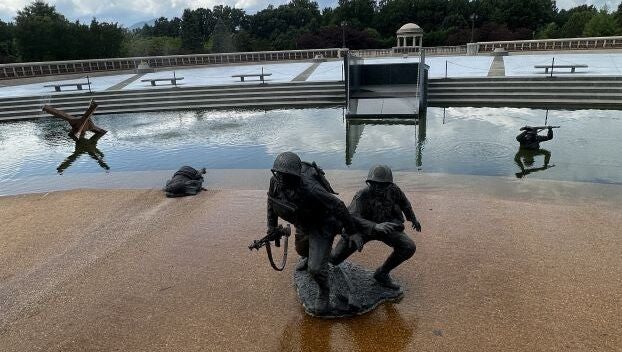D-Day Memorial brings back memories: ‘It is a special place to go’
Published 9:27 pm Thursday, June 6, 2024

- Here’s a look at some of the sights from the D-Day Memorial, taken in 2023 after the annual ceremony. Photos by Brian Carlton.
|
Getting your Trinity Audio player ready...
|
Editor’s note: In honor of the 80th anniversary, we’re sharing Farmville lawyer (and Buckingham’s county attorney) Kemper Beasley’s experience on his latest visit to the D-Day Memorial.
Recently, I completed my annual pilgrimage to the D-Day Memorial in Bedford. This trip is always on or around May 5, the anniversary of my father’s death. I chose this destination because he and I visited the site several times and it is a special place to go and reflect upon him and his role in my life.
My father was born in 1943, in the middle of World War II. His father was a farmer and too old to be drafted to serve in the war. Therefore, I do not have any immediate relatives who participated in the Normandy invasion or served in the military during the war. However, I believe the reason my father was drawn to the memorial, and why I still go, is because it brilliantly honors those who fought and died during D-Day while also recognizing how so many more were affected and participated in this world event.
First sights at the memorial
When you arrive at the D-Day Memorial, your attention is quickly drawn to a large granite arch with the word “Overload” inscribed on it, the code name for the D-Day invasion. Surrounding the arch are sculptures symbolizing the soldiers who landed and fought on the beaches of Normandy. In front of the arch is a plaza with plaques that include the names of the soldiers who died during the invasion, both American and from other countries that participated. Elsewhere on the grounds you will find a statue of Dwight D. Eisenhower, the Supreme Commander of the Allied Forces, along with busts of significant military leaders at the time.
The brilliance of the landmark is that it memorializes not just the soldiers and their military leaders, but so many more. There are busts of Franklin Roosevelt and Winston Churchill to signify some of the political leadership during the war and the grounds of the memorial are full of plaques that highlight different aspects of the war effort, including contributions of American industry and other efforts on the home front.
Bedford’s story at D-Day Memorial
Yet, also intricately woven among all the statutes and plaques are reminders of why the memorial is located in Bedford. This small town lost 20 young men during D-Day, the highest known per capita loss of any locality as a result of the invasion. Therefore, when you walk around the memorial, your attention is drawn to the fact that not only were the soldiers’ lives changed in those fateful days, but communities and families were never the same. For those who have not served in the military, it may be hard to relate to the bravery and sacrifice of the soldiers, but we can all relate to the personal stories shared on the monuments and plaques at the D-Day Memorial.
Our hearts ache when we read the letter that a newly married wife sent her husband expressing excitement about his return, only to discover that the husband died during the invasion before receiving the letter. We grieve for the mother from Bedford who lost two sons as we read the account of how afterward she was never the same and at her death called out to them.
On June 6, the D-Day Memorial marked the 80th anniversary of the start of the invasion at Normandy. Unfortunately, each year there are fewer World War II veterans who attend these ceremonies. Even though their presence is invaluable, the beauty of the memorial is that it honors so many. It also values the contributions during the war of the mother, spouse, business owner, farmer, and so many more. Thus, even though my grandparents never wore a uniform or went overseas, a visit to the D-Day Memorial reminds me that by operating the family farm and raising their kids, they contributed to victory.
Encouraged about the future
As I walk the grounds each year in an effort to remember the special bond I had with my father, I am inspired by the past to be encouraged about the future. I want to live my life in a way that contributes to society, just like so many did eighty years ago. On one of the plaques is inscribed a prayer that a soldier kept in a notebook. I keep a copy of that prayer next to my desk. The prayer includes the lines: “Give me the strength to stand for right, when other folks have left the fight. Give me the courage of the man, who knows that if he wills he can.”
I urge you to reflect on how 80 years ago, a momentous historical event took place by brave soldiers, their leaders, and those that supported them back home. In addition, I encourage you to take your own pilgrimage to the D-Day Memorial in Bedford. There you also will be inspired to follow the footsteps of a previous generation – footsteps on both the sand of Normandy and the soil back home.





